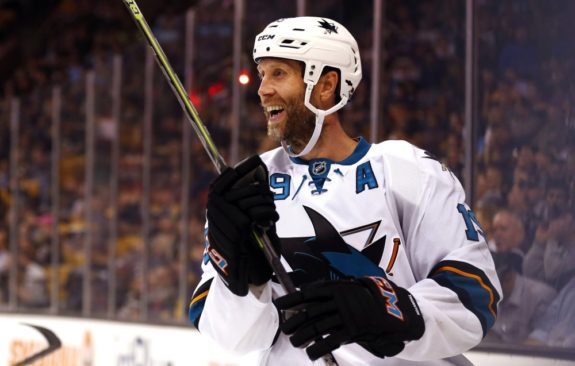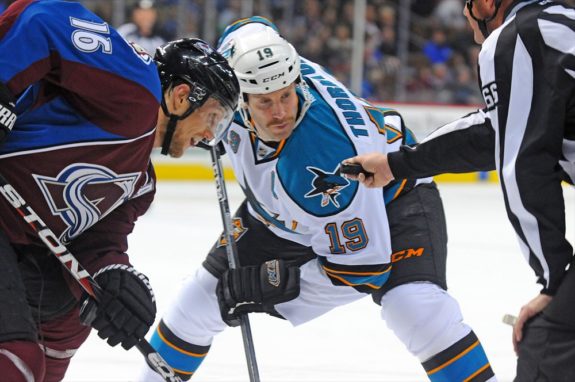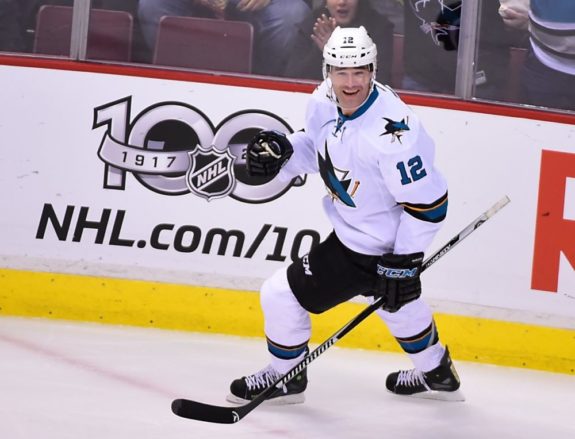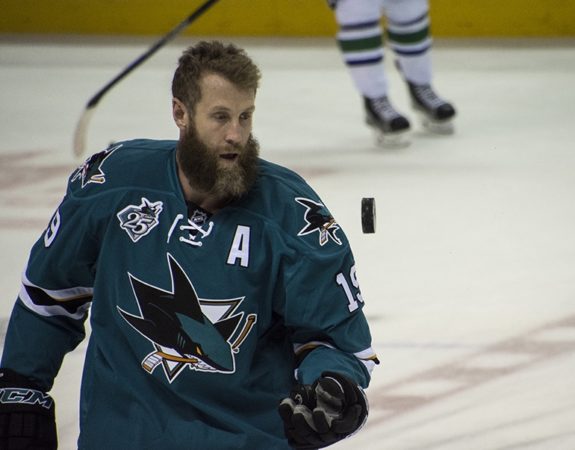Joe Thornton and Patrick Marleau are the two best players in San Jose Sharks history. They’ve been joined at the hip since Thornton’s arrival in 2005. Almost any listing of franchise scoring records will find the two of them first and second. They are also among the most popular Sharks.

Over three years ago, the two players deliberately signed deals on the same day and for nearly the same dollar amount. Apparently they like each other. But on July 1, 2017, those deals are officially over and the two become free agents. They are still available to the Sharks, but also to any other team who might want them. We are at the point when news could break at any moment.
The Rewards
Keeping popular players is good for the fans, but also good for the locker room. Both are respected. The more vocal Thornton continues to be a leader. His friendships run deep, to the point he and beard buddy Brent Burns stripped down and posed for ESPN’s upcoming body issue.
Thornton and Marleau combined for 34 goals and 96 points last season. This production is not easily replaced. However, it is also not the sort of production one hopes for from these two. In the 2015-16 season, Thornton alone had 82 points.

Using the 96 points, we can come up with a nominal salary. The average point total is 48 for each (50 for Thornton and 46 for Marleau), which corresponds to 100th among NHL scoring leaders. Going down the list, we find both the salary and cap hit for the 100th most expensive forward is $4.50 million. San Jose can afford this amount for these players, especially this season.
Keeping the two players maintains continuity and keeps close to 100 points of production in-house. The Sharks are a better team with these two. However, the biggest benefit might be more subtle. Their presence (or absence) may influence the choices others make, including potential free agents. Including current Sharks players.
If Thornton and Marleau depart, it might change the calculus for Marc-Edouard Vlasic and Martin Jones. These are the two most critical contracts for the Sharks. And while they can be renewed anytime in the next year, the longer they linger, the bigger the risk. If these two hesitate to re-sign because Marleau and Thornton are gone, the Sharks may quickly change directions into a full-on rebuild.
The Risks
Did you hear the story about the general manager who once said, “we should have kept the two 38-year-olds.” Neither have I. It is rare a 38-year-old player (let alone two) is the key difference-maker on a championship team. In any sport.

What will Thornton and Marleau bring going forward? In two of the last three seasons, Marleau has been, well, not great. The goal scoring is there, but his all-around game has been uneven. Even though he was plus-4 this past season, over the last three seasons, Marleau is minus-35, which is a frightful 502nd out of 530 players.
Thornton, meanwhile, has been evenly split between Hall-of-Fame great and not so good. Last season was not so good. His 50 points were his lowest output since 1999. He didn’t look right all season. My eyebrows raised when Thornton got knocked to the ice on a minor bump in a game in Minnesota. The person who bumped him to the ice? A linesman, Brian Mach. The year before, big players couldn’t push Thornton off-balance but a bump with a linesman and he went down? Something wasn’t right.
Something wasn’t right in the 2014-15 season either, though we know more in this case. Thornton injured his shoulder in the last game of 2014. He was plus-5 in 39 games to that point. He missed four games, and over the final 39 games, he was minus-9. No doubt, his shoulder injury played a big role in the fall-off.
Throughout the 2015-16 season, Thornton was absolutely brilliant, truly dominating the game.
Over the last three seasons, he has been terrific half the time and just OK half the time, with his health playing an important role.
Auspicious History
In April, Thornton tore two knee ligaments on a play with modest contact (which made me wonder if he was fully healthy at the time). He has had two significant injuries in the last three seasons. He played with both injuries. The man is tough as nails, but his quality of play suffered greatly.
At this point, it is worth retelling the Sharks’ history with damaged knees. Which players came back from knee surgery as good as new? Tomas Hertl? No. Milan Michalek? No. Raffi Torres? No. Jonathan Cheechoo? No. Is it likely the 38-year-old Thornton changes this trend?

The past three seasons show Thorton’s uneven play. Some of this is injury related, but injuries happen and 38-year-olds do not recover as quickly. Specifically, there is not a lot of positive history with 38-year-old players returning to form after tearing two knee ligaments.
A Business Decision
Hockey is a business, and the Sharks have plenty to consider with Marleau and Thornton. If both leave, San Jose will be swimming in cap space for the first time in a long time. But swimming in cap space is only useful if San Jose attracts the difference-making free agents who fill the void and greatly improve the team.
Logic flashes bright red warning signs about re-signing them, especially to the three-year deals they are rumored to want. Professional athletes consistently overestimate what they have left to give as they age. The mixed results over the past three seasons, coupled with Thornton’s recent knee surgery, make this a dicey call.

The flip side is they showed they were still good players last season. A considerable drop off came from Thornton, but it was a rebound season for Marleau, who benefitted from less use. Still, out of the last six seasons (three each), they’ve been really good for roughly 2.5 seasons.
The Sharks have tickets to sell, other players to keep and a pretty good roster. Bringing both back makes sense at the right price and term. So what might “right” look like?
One Direction
The Sharks have a reasonable amount of cap space this season. They’ll want to keep room for a trade opportunity, but they have ways to wiggle on this front. Next season, they may find things a bit tighter, as major raises are due both Vlasic and Jones.
There is a way to offer a two-year deal by offering two one-year deals. The first deal pays above market, the second deal pays below. Only one deal can be signed this offseason, but the second deal can be signed in January, long before another free agency. The terms, though, can be discussed now. Paying these players roughly $5.5 million for this season and $3.5 million for next pays them comparably to their most recent performance. Thornton has a knee issue which may idle him for a portion of the season, making $5.5 million for this season quite generous.
This approach addresses the team’s cap situation while removing the risks associated with nearly 100 points leaving, along with other repercussions from locker room to ticket sales. Whether the two players are on board, however, is another issue.
Should other teams offer these players contracts which exceed $15 million and have the desired three-year term, though, it is hard to see the Sharks matching. In which case, the legends move on and a new reality begins for San Jose.